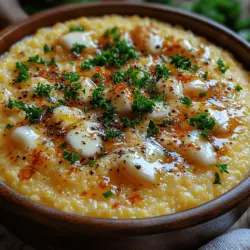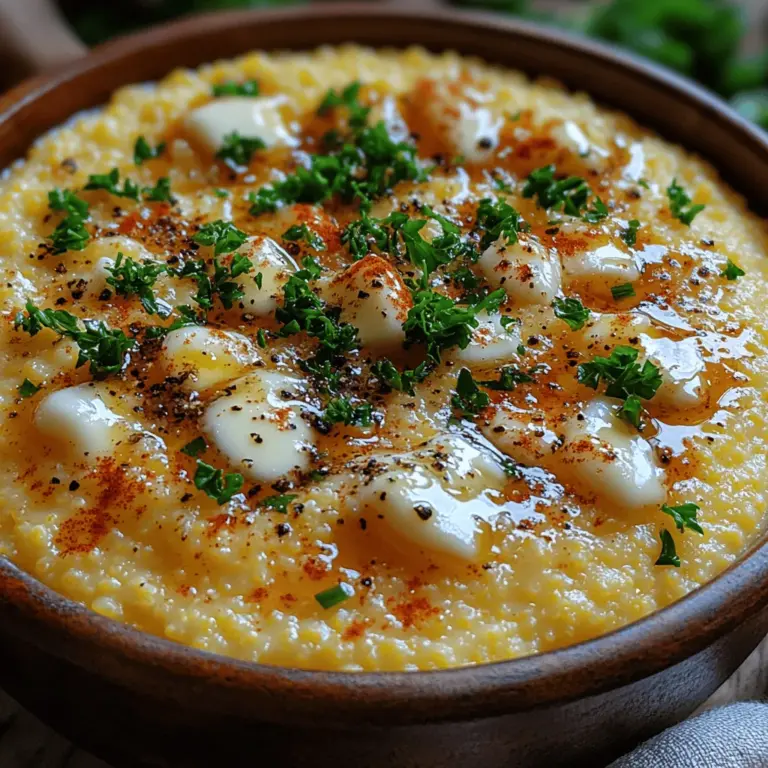Introduction
When it comes to comfort food, few dishes can rival the creamy, rich texture of polenta. This beloved Italian staple has roots that trace back centuries, and its versatility makes it a favored canvas for an array of flavors. One standout variation that captivates taste buds is Peppery Garlic Parmesan Polenta. This recipe combines the earthy tastes of cornmeal with the robust flavors of garlic and the sharpness of Parmesan cheese, creating a dish that is as comforting as it is indulgent.
Polenta holds a special place in many kitchens around the world, celebrated not only for its simplicity but also for its ability to adapt to various culinary traditions. The primary ingredients—cornmeal, garlic, and Parmesan—come together to create a dish that is not only satisfying but also rich in flavor. The peppery notes add a delightful kick, elevating the dish to new heights. Whether served as a side or a main course, this Peppery Garlic Parmesan Polenta is sure to impress.
Reflecting on my own culinary journey, I recall the first time I savored a bowl of creamy polenta at a quaint Italian eatery. I was instantly enamored by its velvety texture and the way it effortlessly absorbed the flavors of the accompanying sauce. Inspired by that experience, I decided to recreate a similar dish at home, experimenting with different ingredients until I landed on this perfect combination. The result? A dish that not only pays homage to its Italian roots but also adds a modern twist that is sure to delight anyone who tries it.
Understanding the Recipe
Description and Origins of Polenta
Polenta is made from ground cornmeal, a staple in Northern Italian cuisine. Traditionally, it was a peasant food, affordable and filling, often served alongside stews or grilled meats. Its origins can be traced back to the Roman Empire, where it was initially made from other grains like farro before corn became the go-to ingredient in the Americas and Europe in the 16th century. The dish has evolved over the years, transforming from a simple porridge into a versatile ingredient that can be baked, fried, or grilled.
Cultural Background
In Italian culture, polenta is more than just food; it symbolizes comfort and home. Each region has its own take on this classic dish, whether it’s the creamy version enjoyed in the north or the firmer, sliced variety found in the south. Families often gather around the table to enjoy polenta, making it a cherished meal that brings loved ones together. The simple yet robust nature of polenta allows it to be paired with a multitude of ingredients, making it a beloved dish in various culinary traditions.
Historical Significance and Traditional Variations
Historically, polenta has been a staple for rural communities, providing sustenance and nourishment. It has been a canvas for creativity, with each region adding its own flair—be it mushrooms in the north, rich meats in the center, or vibrant vegetables in the south. As culinary techniques advanced, polenta became a gourmet dish, gracing the menus of fine dining establishments while still maintaining its roots in everyday cooking.
Key Ingredients and Their Roles
The beauty of Peppery Garlic Parmesan Polenta lies in its simplicity, with a handful of key ingredients playing a pivotal role in flavor development.
– Cornmeal: The base of the dish, providing the creamy texture and a subtle nutty flavor.
– Garlic: Adds depth and aroma, infusing the polenta with a rich, savory quality.
– Parmesan Cheese: Introduces a salty, umami component, enhancing the overall flavor profile.
– Black Pepper: The star of this dish, delivering warmth and a hint of spice that elevates the dish from simple to extraordinary.
– Butter: Used for creaminess and richness, making the polenta indulgently smooth.
Main Ingredients and Their Flavors
The combination of these ingredients creates a harmonious blend of flavors. The sweetness of the cornmeal complements the sharpness of the Parmesan, while the garlic provides a robust backbone. The black pepper adds a touch of heat, balancing the richness of the dish. Together, they create a comforting and satisfying experience that will leave you craving more.
Optional Ingredients and Substitutions
One of the remarkable aspects of polenta is its adaptability. While the main ingredients are essential to achieving the classic flavor, there are plenty of optional ingredients and substitutions that can tailor the dish to your palate.
– Herbs: Fresh herbs like thyme, rosemary, or parsley can add a burst of freshness.
– Cream: For even creamier polenta, consider adding a splash of heavy cream or milk during the cooking process.
– Cheese Variations: If Parmesan isn’t available, Pecorino Romano or Gruyère can offer a different twist.
– Vegetable Stock: For a more pronounced vegetable flavor, substitute water with vegetable stock when cooking the polenta.
With these variations, you can easily customize the dish to meet your taste preferences or dietary needs.
Preparation Steps
Detailed Preparation Process
Creating Peppery Garlic Parmesan Polenta is a straightforward process that can be broken down into simple steps. Follow these guidelines to achieve the perfect polenta.
1. Gather Your Ingredients: Before you begin, ensure you have all your ingredients ready. This includes cornmeal, garlic, Parmesan cheese, butter, black pepper, and water (or broth, if using).
2. Mince the Garlic: Start by finely mincing the garlic. The more finely you chop it, the more flavor it will impart into the polenta. If you prefer a milder garlic flavor, consider sautéing it in butter first to soften its intensity.
3. Measure the Cornmeal: Decide how much polenta you want to prepare. A typical serving size is about 1 cup of cornmeal to 4 cups of water or broth. Measure accordingly.
4. Boil the Liquid: In a medium saucepan, bring your water or broth to a rolling boil. This is crucial as it ensures that the cornmeal cooks evenly.
5. Whisk in the Cornmeal: Once the liquid is boiling, reduce the heat to low and gradually whisk in the cornmeal. Whisking continuously will help prevent lumps from forming, ensuring a smooth texture.
6. Cook Until Thickened: Allow the polenta to simmer for approximately 30-40 minutes, stirring frequently. The polenta will thicken as it cooks, and you will notice it pulling away from the sides of the pot when it’s ready.
Step-by-Step Breakdown of the Cooking Method
– Whisking: As you add the cornmeal, whisk vigorously to incorporate it into the boiling liquid. This step is essential for achieving a creamy consistency.
– Simmering: After whisking in the cornmeal, reduce the heat to low. This gentle simmer allows the polenta to cook slowly, giving it time to absorb the liquid and become tender.
– Stirring: Stir the polenta frequently, making sure to scrape the bottom of the pot to prevent sticking. This process helps to create a smooth and creamy texture.
Tips for Efficient Ingredient Preparation
– Pre-chop Garlic: If you’re short on time, consider using pre-minced garlic or garlic powder. However, fresh garlic will give you the best flavor.
– Use a Non-Stick Pot: To avoid sticking and make cleanup easier, use a non-stick saucepan for cooking your polenta.
Cooking Techniques Involved
The preparation of Peppery Garlic Parmesan Polenta involves several essential cooking techniques that contribute to the final dish’s flavor and texture.
– Sautéing: If you choose to sauté the garlic before adding it to the polenta, this technique will mellow the garlic’s bite and create a fragrant base.
– Simmering: This slow cooking technique is vital for allowing the cornmeal to hydrate fully, resulting in a creamy texture.
– Whisking: Continuous whisking while adding the cornmeal prevents lumps and ensures an even consistency.
Importance of Technique in Achieving Flavor and Texture
The techniques used in making polenta are integral to achieving its signature creamy texture and rich flavor. Whisking while adding the cornmeal ensures the grains are evenly dispersed in the liquid, preventing lumps and allowing for a smooth finish. Simmering the polenta patiently allows the flavors to meld while ensuring proper cooking and hydration of the cornmeal. Mastering these techniques will empower you to create a delicious polenta dish that is both comforting and impressive.
As we continue to explore the flavor profiles of Peppery Garlic Parmesan Polenta, you’ll discover the delightful balance of sweet, savory, and spicy elements that make this dish a standout. From the warmth of freshly cracked black pepper to the rich umami of Parmesan cheese, every bite is a celebration of flavor. Stay tuned to delve deeper into the delicious world of polenta and discover how to enhance its profile with thoughtful pairings and cooking tips!
{{image_2}}
Ideal Side Dishes and Accompaniments
Peppery Garlic Parmesan Polenta is a versatile dish that pairs beautifully with a variety of side dishes and accompaniments. When planning your meal, consider serving it alongside sautéed greens such as spinach or kale, which add a fresh and vibrant contrast to the creamy texture of the polenta. Roasted vegetables, particularly root vegetables like carrots, beets, or sweet potatoes, complement the earthy flavors of the polenta while providing a satisfying crunch.
Additionally, grilled meats such as chicken or steak can enhance the meal’s heartiness, making it suitable for a more substantial dinner. If you’re looking for a lighter option, a crisp salad with a tangy vinaigrette can balance the richness of the polenta. For those who enjoy seafood, grilled shrimp or pan-seared scallops can provide a delightful contrast, making for an elegant dining experience.
Wine or Beverage Pairings
Selecting the right beverage to accompany Peppery Garlic Parmesan Polenta can elevate your dining experience. For white wine lovers, a crisp Sauvignon Blanc or a lightly oaked Chardonnay pairs beautifully, highlighting the dish’s garlic and Parmesan flavors. If you prefer red wine, consider a medium-bodied Pinot Noir, which offers enough acidity to balance the richness of the polenta without overwhelming it.
For non-alcoholic options, a sparkling water infused with lemon or cucumber can refresh the palate. Herbal teas, such as chamomile or mint, can also serve as an excellent accompaniment, providing a soothing counterpoint to the dish.
Serving Suggestions
Presentation Ideas for the Dish
When serving Peppery Garlic Parmesan Polenta, presentation is key to making the dish visually appealing. Start by spooning the creamy polenta into a shallow bowl or onto a plate. A swirl of extra-virgin olive oil drizzled on top can add a glossy finish, while a sprinkle of freshly cracked black pepper enhances both flavor and appearance.
For a more rustic presentation, consider using a wooden board or slate platter to serve the polenta, allowing guests to scoop their portions directly. This approach adds a communal feel to the meal and encourages sharing.
Plating Techniques to Enhance Visual Appeal
To create an inviting plate, use the layering technique. Begin with a base of polenta, then layer on your sautéed greens or roasted vegetables. Place your protein choice, such as grilled chicken or shrimp, on top, and finish with a garnish of fresh herbs like parsley or basil. This method not only looks appealing but also allows for a combination of flavors in every bite.
Garnishing Tips for Added Flavor and Aesthetics
Garnishing can transform a simple dish into a masterpiece. For Peppery Garlic Parmesan Polenta, consider adding a handful of microgreens or arugula for a pop of color and a hint of peppery flavor. Shaved Parmesan or crumbled feta cheese can also add a touch of elegance and additional creaminess. A few chili flakes can introduce a subtle heat, making the dish more dynamic.
Ideal Occasions for Serving the Dish
This polenta dish is perfect for various occasions. For family gatherings, it serves as a comforting side dish that complements hearty mains. During the holidays, it can be a sophisticated addition to your festive table, appealing to both traditional and modern palates. For casual meals, it offers a quick and satisfying option, allowing for flexibility in pairing with different proteins and vegetables.
Nutritional Information
When it comes to nutritional value, Peppery Garlic Parmesan Polenta is rich in essential nutrients. A serving typically contains around 250 calories, with a good balance of carbohydrates, fats, and proteins. The polenta itself, made from cornmeal, is gluten-free and offers a source of complex carbohydrates, making it a great energy source.
Breakdown of the Nutritional Value of the Dish
– Calories: Approximately 250 per serving
– Macronutrients:
– Carbohydrates: 40g
– Protein: 6g
– Fat: 9g
– Vitamins and Minerals: Rich in Vitamin A, Vitamin C, magnesium, and potassium.
Health Benefits of Key Ingredients
The primary ingredients in this recipe contribute to its health benefits. Cornmeal, the base of polenta, is high in fiber, which aids digestion and helps maintain a healthy gut. Garlic is known for its anti-inflammatory and immune-boosting properties, while Parmesan cheese adds calcium and protein to the dish. Olive oil, often used for drizzling, is rich in healthy fats that support heart health.
Variations for Dietary Needs
For those with dietary restrictions, Peppery Garlic Parmesan Polenta can be easily modified. To make it vegan, substitute the Parmesan cheese with nutritional yeast or a vegan cheese alternative. For a low-carb version, consider using cauliflower polenta as a substitute for traditional cornmeal.
If gluten-free is a priority, rest assured that polenta is naturally gluten-free. Adjusting the recipe for different dietary preferences can be simple and still yield delicious results.
Common Mistakes to Avoid
While making Peppery Garlic Parmesan Polenta is straightforward, a few common pitfalls can affect the final outcome.
Common Pitfalls in Making the Dish
1. Overcooking the Polenta: This can lead to a gummy texture. Cook the polenta just until it thickens, then immediately remove it from the heat.
2. Under-Seasoning: Polenta can be bland if not seasoned adequately. Taste as you go and adjust the salt and pepper to your liking.
3. Incorrect Ingredient Ratios: Using too much or too little liquid can drastically affect the consistency. Follow the recommended ratios for best results.
Troubleshooting Tips for Common Issues
If your polenta turns out too thick, simply whisk in a little extra hot water or broth to loosen it. If it’s too thin, continue cooking it on low heat while stirring until it thickens to the desired consistency. Should you find the flavor lacking, consider adding more garlic, cheese, or herbs to enhance the dish.
How to Salvage a Dish That Didn’t Turn Out as Expected
If your polenta ends up clumpy or lumpy, you can rescue it by blending it with a stick blender or transferring it to a food processor. This will create a smooth texture. If it’s overly salty, a splash of cream or a bit of unsalted broth can help balance the flavors.
Conclusion
Peppery Garlic Parmesan Polenta is not just a dish; it’s an invitation to explore the myriad of flavors and textures that cooking has to offer. Its creamy, rich base serves as a canvas for a variety of accompaniments, allowing you to tailor your meal to any occasion. From family gatherings to elegant dinner parties, this versatile polenta can shine on any table.
The joy of cooking lies not only in following recipes but also in the creativity that comes with experimenting. Whether you stick to the classic version or modify it to suit your dietary needs, this dish encourages you to try new flavors and techniques. So gather your ingredients, invite your loved ones to the table, and enjoy the experience of sharing a meal together—after all, that’s what cooking is all about.



